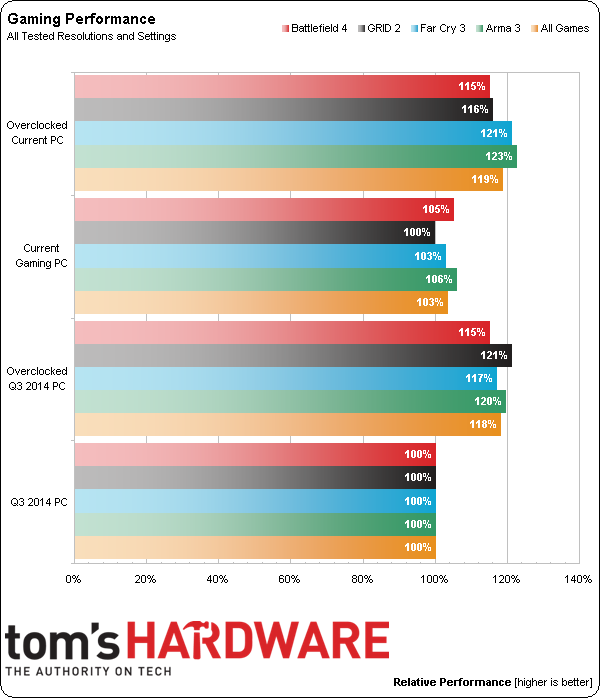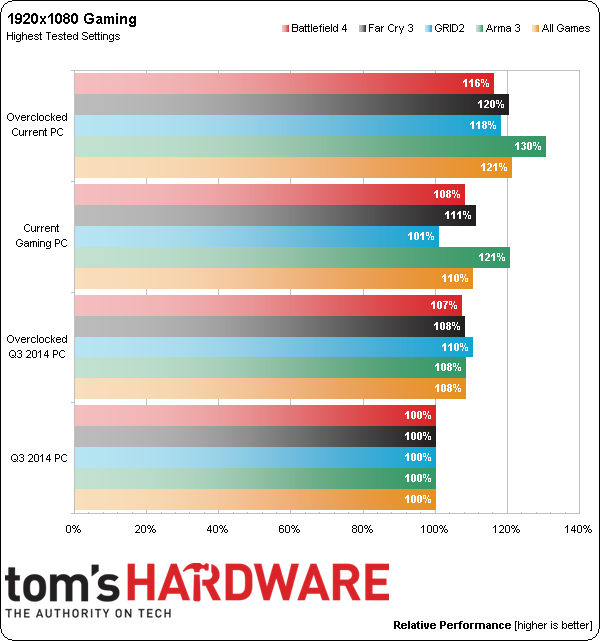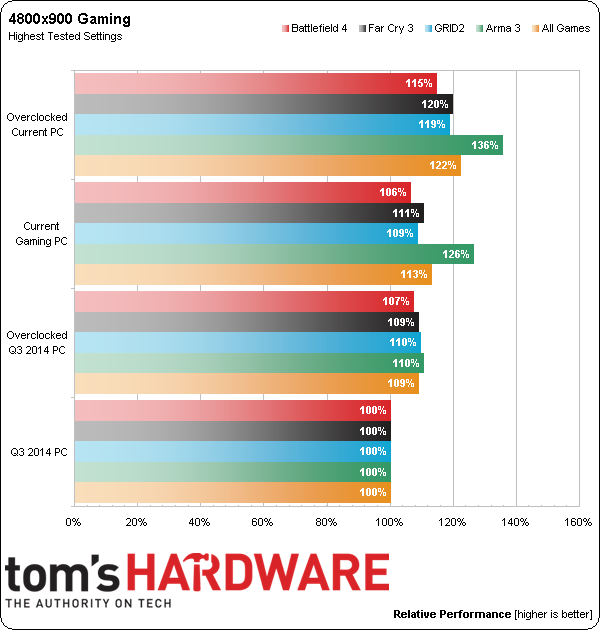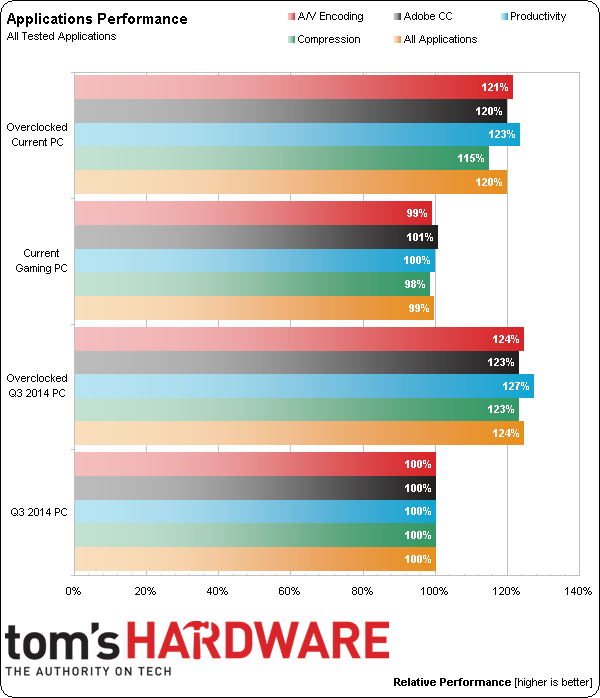System Builder Marathon Q4 2014: Budget Gaming PC
Performance Summary
Let’s wrap up how well our most recent pair of budget Gaming PCs measure up to one another. As is typical in this series, we’ll use the older machine as a baseline.
Tallying average frame rates throughout all resolutions leans heavily on the Pentium G3258 processor, and our GPU upgrade to R9 270X nets just a few percentage points. And it was no surprise to see the two machines so close once overclocked also, as less aggressive overclocking with EIST enabled capped frame rates at lower resolutions, albeit if only by meaningless amounts.
Cranking up the eye candy at 1920x1080 obviously shifts demands over towards the Radeon graphics pairings, favoring our new machine’s GPU speed bump. As built, it even appears to outpace last quarter’s overclocked efforts. However that’s deceiving, as these demanding settings often required the Pentium to be overclocked. Once tuned, the new machine truly shined, winning the numbers race in all four titles. The real world benefits were a bit more subtle, as we really couldn’t say an additional three to five FPS was felt in-game. Mainly it will come into play within GPU heavy titles by allowing us to enable or slightly bump up the levels of anti-aliasing. It’s still an improvement, nonetheless.
Our new PC was clearly the winner for triple-panel Eyefinity gaming, although its R9 270X graphics card still required settings tuned down in three of the four titles. And unless you are pinching every penny, we’d imagine the added expense of even beefier graphics, as well as a trio of displays, totally warrants a more potent processor also.
Our new PC took a 100MHz hit in overclocking and suffered slightly reduced memory bandwidth. These machines are so similar, it’s doubtful any difference could be felt apart from a few extra seconds spent compressing large folders. These two builds could double as fine office PCs, but they are not meant to be workhorses. Any dual-threaded processor is bound to feel downright slow when tackling lengthy, heavily threaded, workloads.
Get Tom's Hardware's best news and in-depth reviews, straight to your inbox.
Current page: Performance Summary
Prev Page Power Consumption And Temperatures Next Page Do We Miss the Trimmings?-
airplanegeek Why is the PSU fan facing up instead of down? Doesn't that affect the cooling of the PSU?Reply -
sea monkey Upon submission of the form:Reply
The Sweepstakes opens on September 23, 2014 12 noon PDT and closes on October 6, 2014 12 noon PDT.
Umm... -
pauldh Yes it would. And it is facing down, just hidden from sight in the photo. The PSU fan's venting holes are flush with (and actually a part of) it's shell.Reply -
Zeh Just a hint: you SHOULD be using an air conditioner so you can have the same room temperature over the year.Reply
Preferably one with Inverter technology, which will decrease the temperature delta (it doesn't start-stop once it reaches a given temperature threshold). -
Onus Hmmm, I see some kudos for the VP-450 in here, being remarkably efficient despite not being 80+ (it is disqualified for 80+ for not having Active PFC).Reply
Since the purpose of these SBM machines is (imho) to learn things, I would have liked to have seen a different mobo used, for comparison.
I appreciate the thoughtful approach to overclocking that was used here.
The only niggle I can't resist is the $18 for the optical drive. For months, I've been seeing one or another of them for around $13-$14. That seems a small thing, but that $4-$5 plus the leftover may have bought either a better cooler or a faster HDD.
-
sea monkey Replytotally disappeared from site
sight
while monitor temperatures
monitoring
to be sure it could bee done
be
none the less
nonetheless
it’s R9 270X graphics card
its
Yet, both machines share a similar weakness, they’re outfitted with a dual-core Pentium capable of juggling only two threads at a time.
comma splice
outputting to 3-panels
three panels
-
lesmore2222 I agree with cody. I really wanted to see the difference a r9 280 would make as well. This was just too similar to the last build. Should have bought the r9 280 anyway and fibbed on the price a little. ;)Reply -
ingtar33 ReplyA final thought to consider is at what point will the next big game on your radar force an early upgrade to Core i5? It might not be too far off, as Far Cry 4, which launched a week after we ordered this machine, completely lacks official support for dual-threaded processors.
same with the game of the year, Dragon Age Inquisition.
I suspect it's time to drop dual cores as a build suggestion. -
BoredSysAdmin Great build. I would probably never built it exactly like the article (more ram, sdd - etc), but it provides great bones to build upon.Reply




